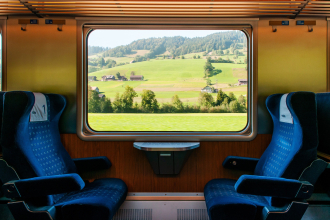
Rail & Environnement
The European Union Agency for Railways (ERA) supports the European Commission’s Green Deal strategy and contributes to achieving the EU climate and energy targets.
The European Union Agency for Railways (ERA) supports the European Commission’s Green Deal strategy and contributes to achieving the EU climate and energy targets through the following actions:
The impact of transport on the environment and society is substantial, as it produces approximately 25% of total EU greenhouse gas (GHG) emissions. GHGs and other air pollutants emitted from the transport sector and other sectors have serious consequences for the health of Europeans. Beyond air pollution, transport is an important source of noise, and the use of land for its infrastructure has a long-term effect on biodiversity. In addition, externalities such as congestion and accidents are negative consequences of the European transport system.
In the transport system, rail is the mass transport mode with the lowest GHG emissions and external costs, the highest degree of energy independence (especially if the energy comes from the EU’s renewable sources), the highest efficiency in land-take and the most durable assets. This gives rail several green competitive advantages over other modes of transport and the potential to become the backbone of a multimodal transport system.
Launched in 2019, the European Green Deal responds to citizens’ urgent call for climate action. It sets out a plan to transform Europe’s economy, energy, transport, and industries for a more sustainable future.
It aims to cut emissions by at least 50% by 2030, rising towards 55%, while legally binding the 2050 neutrality goal through the European Climate Law. It pushes forward a clean transition that protects people and planet, is economically sound and socially fair.